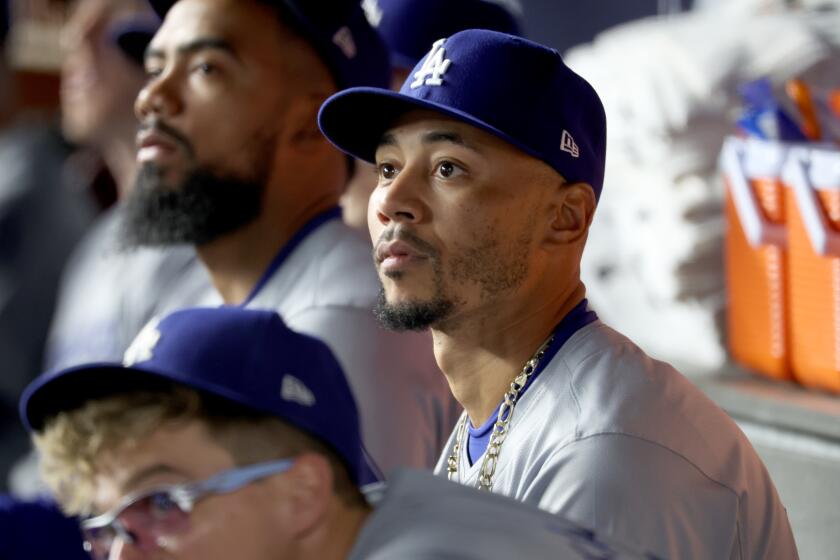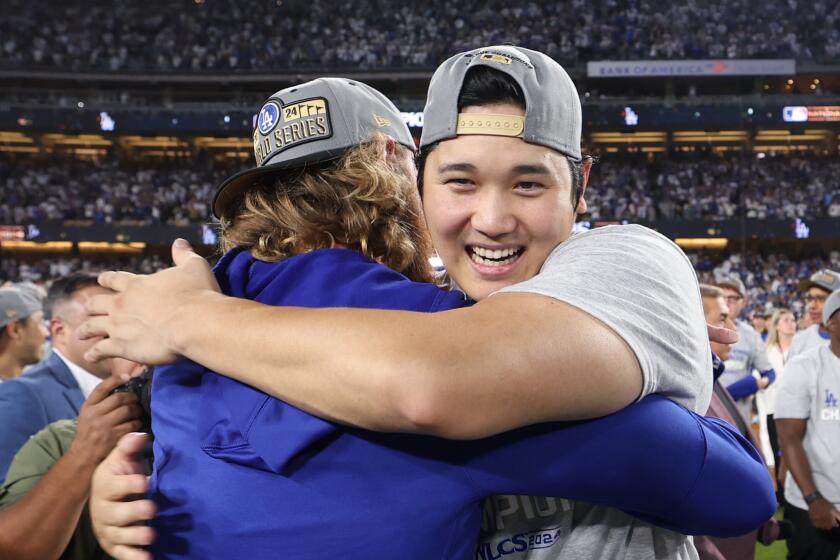He Slays Batters, but Softly
I’ve always thought it was the best pitch in baseball. The fastball? Naw. Big league hitters sit on the fastball and sooner or later connect. The curveball? Well, if it doesn’t hang, all right. But good hitters--say, Willie Mays--could put the curve in the center-field seats. The slider? Fresco Thompson always said the slider was the pitch that broke Babe Ruth’s record and would put Roger Maris in the Hall of Fame (but hasn’t yet). It had “gopher” written all over it.
No, the pitch I have always been in awe of is the one ballplayers call “the moth,” “the dancer,” “the feather.” It comes up to the plate like a guy going to the electric chair. Or a hound dog crossing a field.
It’s the knuckleball, that eccentric nonpitch that is to baseball what the phantom was to the opera. You know it’s there; you can’t find it.
Tom Candiotti, who has a dandy, has this to say of the knuckleball: “It’s a pitch the hitters can’t hit, the catchers can’t catch and the umpires can’t call.” John Roseboro, when he caught for the Dodgers, used to say: “If a ball curves or slides on the way to the plate, it might be ill-meant. But if it disappears on the way to the plate, it might be illegal. But only the knuckleball has a mind of its own.”
The knuckleball is legal enough. It’s not the spitball, which comes in at velocities that might kill. The knuckler couldn’t kill a fly on a wall if it hit it direct. The knuckler comes in like a soap bubble. Even if you manage to get a piece of it, it’s not going far. You have to supply all the muscle. Power pitchers worry about the gopher ball--Bert Blyleven gave up 50 one year, Robin Roberts yielded 505 in his career. Candiotti gave up only 12 homers last year, almost none of them on knucklers.
You would think with a pitch like this, the big leagues would be awash with knucklers. But the knuckleballers emerge only every other generation. So far as can be determined, only one knuckleballer, Hoyt Wilhelm, ever made the Hall of Fame. And he had to appear in 1,070 games, more than any pitcher, to qualify.
One of the troubles with the knuckler is that catchers, as a class, hate it. Its flight to the plate is so unpredictable, its orbit is untrackable. Bob Uecker, once asked how he caught the knuckleball, answered: “You wait till it stops rolling, then pick it up.”
Catchers are even issued special mitts, about the size of a pizza with everything, to try to catch it. “You should have a basket,” Gus Triandos once grumbled.
It was the pitch that put catchers in the record books for most passed balls. Official scorers were loathe to call a pitch that floated to the plate a wild pitch even though it was harder to corral than a mosquito on a hot night.
Baserunners take liberties with it. Managers are not too crazy about it. Their ulcers begin to act up when there’s a runner on third and a knuckler to catch.
Still, there has never been a batter who could properly time and chart the true knuckler. Even if you meet it, it’s like teeing off on a wad of cotton.
Tom Candiotti would probably not be a big league pitcher without a knuckleball. “I started fooling around with it because it was a fun thing to do,” he said. “I didn’t take it seriously.”
Candiotti wasn’t even drafted out of high school. Major league scouts don’t go after pitchers with 85-m.p.h. fastballs and Little League curves. “I was no threat at all to the radar gun,” Candiotti said.
He was able to enter college (St. Mary’s) unimpeded. He was even able to graduate. He had an outstanding pitching career there, but big league bird-dogs historically pay no attention to control pitchers, either. He signed on as a free agent with the Victoria team in British Columbia.
He went 5-1 there and the Milwaukee Brewers signed him without much enthusiasm. His numbers were good--his earned-run average stayed in the 2s--but he bounced around the low minors for most of seven years. Milwaukee was so unimpressed, the club allowed him to drift into free agency.
He experimented with his knuckleball in the minors, but it was not until he signed with Cleveland for the 1986 season that Candiotti saw his future.
On the Cleveland Indians of that time was the patron saint of modern knuckleballers, Phil Niekro, “Knucksie” to his teammates. Niekro, who will be in the Hall of Fame, was 47 years old that season but went 11-11--which is certainly Cooperstown stuff with the Cleveland Indians.
Knucksie was an eye-opener for the struggling young Candiotti. Also an inspiration. He won 318 games during his career throwing mainly knuckleballs. He taught the young Candiotti some of the refinements of the pitch.
Candiotti’s knuckler is effective because it is thrown with more velocity than most. It can come camouflaged as a fastball. He won 16 games with it in ’86 for Cleveland.
Nor are walks, the Catch-22 for most knuckleball pitchers, a problem for Candiotti. He walked 73 last year, 55 the year before. That wouldn’t be a good month for Bob Feller, who once walked 208 in a season.
Candiotti and his dancer have become the stopper (the pitching stint that stops the bleeding and halts the losing streaks) for the Dodgers this season. A sunny, direct person with an outlook as positive as a letter-high fastball (“I can’t believe they’re paying me good money to have this good a time”), Candiotti might yet certify his “out” pitch as the best one in baseball. If he lasts as long as Phil Niekro, check him out 300 games from now. That’ll be 2004.
More to Read
Are you a true-blue fan?
Get our Dodgers Dugout newsletter for insights, news and much more.
You may occasionally receive promotional content from the Los Angeles Times.







